Human Orbital Spaceflights
![]()
International Flight No. 115Soyuz TM-4Soyuz TM-6OkeanUSSR |
 |
![]()
Launch, orbit and landing data
walkout photo |
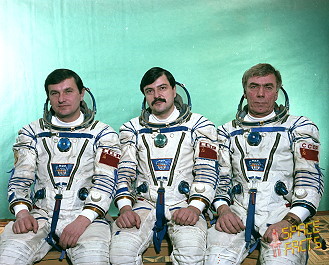 |
|||||||||||||||||||||||||||||||
alternative crew photo |
alternative crew photo |
|||||||||||||||||||||||||||||||
alternative crew photo |
alternative crew photo |
|||||||||||||||||||||||||||||||
alternative crew photo |
alternative crew photo |
|||||||||||||||||||||||||||||||
Crew
| No. | Surname | Given names | Position | Flight No. | Duration | Orbits | |
| 1 | Titov | Vladimir Georgiyevich | Commander | 2 | 365d 22h 38m 38s | 5790 | |
| 2 | Manarov | Musa Khiromanovich | Flight Engineer | 1 | 365d 22h 38m 38s | 5790 | |
| 3 | Levchenko | Anatoli Semyonovich | Research Cosmonaut | 1 | 7d 21h 57m 33s | 125 |
Crew seating arrangement
|
 |
|
||||||||||||||||
Backup Crew
|
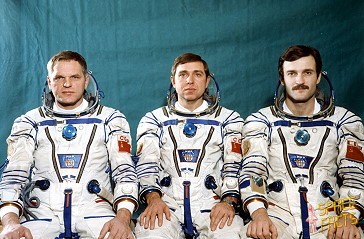 |
||||||||||||||||||||
alternative crew photo |
|||||||||||||||||||||
alternative crew photo |
Hardware
| Launch vehicle: | Soyuz-U2 (No. I15000-020) |
| Spacecraft: | Soyuz TM-4 (7K-STM No. 54) |
Flight
|
Launch from the Baikonur Cosmodrome and
landing with Soyuz TM-6 169 km
southeast of Dzheskasgan. Following a two-day solo flight Soyuz TM-4 docked with the Mir on December 23, 1987. Vladimir Titov and Musa Manarov became the third resident crew of Mir. Musa Manarov and Vladimir Titov travelled to Mir aboard Soyuz TM-4 together with test pilot cosmonaut Anatoli Levchenko. Soyuz TM-4 maneuvered through orbits of 168 x 243 km, 255 x 296 km, and 333 x 359 km before docking with Mir at 12:51 UTC December 23, 1987. Anatoli Levchenko returned to earth aboard Soyuz TM-3 together with the Mir-2 crew. Soyuz TM-4 with the Mir-3 crew aboard arrived at Mir on December 23, 1987. Before departing Mir, the Mir-2 crew of Yuri Romanenko and Aleksandr Aleksandrov demonstrated use of EVA equipment to the Mir-3 crew. The Mir-3 crew delivered biological experiments, including the Aynur biological crystal growth apparatus, which they installed in Kvant. The combined crews conducted an evacuation drill, with the Mir computer simulating an emergency. Soyuz TM-3 departed on December 29, 1987 and the crew settled in for their one-year mission. Soyuz TM-4 was flown to the front port of Mir on December 30, 1987, clearing it for the next Progress freighter. Progress 34 arrived at Mir and remained docked from January 23, 1988 - March 04, 1988. Meanwhile Vladimir Titov and Musa Manarov conducted part of an ongoing survey of galaxies and star groups in the ultraviolet part of the spectrum using the Glazar telescope on Kvant. The survey required photography with exposure times up to 8 minutes. Even small cosmonaut movements could shake the complex. This produced blurring of astronomical images, so all cosmonaut movements had to be stopped during the exposures. On February 12, 1988 the cosmonauts began preparations for an EVA to replace and augment Mir's solar arrays. They tested their EVA suits February 23, 1988 - February 25, 1988. The first spacewalk was conducted on February 26, 1988 (4h 25m). On February 15, 1988, Vladimir Titov and Musa Manarov underwent an inflight refresher course in the fine art of changing solar array sections by watching a videotape of their own preflight practice sessions in the Hydrolaboratory. On February 19 and 23, 1988 they inspected their Orlan-DM space suits. On this date they opened one of the four radial berthing ports in Mir's transfer compartment while out of communication with the TsUP, prepared their work site at the base of the solar array installed by the Mir-2 cosmonauts in June 1987, and replaced one of four sections of the array. This entailed "collapsing" the lower extendible boom to fold shut both solar array sections attached to it. The new section was, like the one it replaced, made up of eight leaves of solar cells. Carbon-plastic composite replaced metal in the new section, however, and six of the leaves used improved solar cells that produced as much power as eight conventional leaves while better withstanding the rigors of space. The remaining two leaves were instrumented and independently replaceable, providing a test site for new solar cell materials. The cosmonauts stood in foot restraints while they worked, continuing the EVA restraint tests begun on Mir-2. They redeployed the extendible boom, unfolding the new section and exposing it to sunlight. To round out the EVA, Musa Manarov and Vladimir Titov moved back along the Kvant module to inspect the rendezvous antenna on Progress 34 (it was late in opening), televised Mir's exterior and the Soyuz TM-4 spacecraft for the benefit of engineers on Earth, and replaced space exposure cassettes. On March 17, 1988 the cosmonauts studied the effects of noise produced by fans and other equipment on their living quarters as part of the Akustika experiment. During the same period, a Soviet spokesman stated that dust and odours on Mir bothered the cosmonauts. Progress 35 arrived and remained docked to Mir from March 25, 1988 - May 05, 1988. In late March and early April, Vladimir Titov and Musa Manarov installed and tested a new telefax system and unspecified equipment to improve communications between Mir and Earth. During May a particle the Soviets identified as a piece of space debris blasted a crater in a two-pane Mir viewport. The damaged area was 6-8 mm across. Progress 36 arrived and docked to Mir's aft port from May 15, 1988 - June 05, 1988. It was replaced with Soyuz TM-5 on June 09, 1988 - June 17, 1988. This brought a Bulgarian cosmonaut to the station. Due to the Soyuz 33 failure, Bulgaria was the only east European Soviet ally not to have had a citizen visit a Soviet space station. Bulgarian Research Cosmonaut Aleksandr Aleksandrov used nearly 2,000 kg of equipment delivered by Progress freighters to conduct 46 experiments in the Shipka program during his stay. The visiting crew left aboard Soyuz TM-4, leaving the fresh Soyuz TM-5 as a lifeboat. The Mir-3 crew flew this from the aft to fore port of Mir on June 18, 1988, leaving the aft port ready for the next Progress freighter. Both cosmonauts went out the space station again on June 30, 1988 (5h 10m) for an unrehearsed EVA. The joint Dutch-British-Soviet TTM X-ray telescope gave trouble soon after launch on the Kvant module in April 1987, so engineers proposed and received approval for an EVA to replace its detector. The TTM telescope was not designed for EVA servicing. Some tools for the repair were developed by Dutch and Soviet scientists and delivered by the Soyuz TM-5 crew. Before going outside, Vladimir Titov and Musa Manarov received a familiarization briefing from British researchers who helped design and build the detector. During the EVA Dutch TTM researchers stood by in the TsUP. The cosmonauts cut through 20 layers of thermal insulation to reach the 40-kg (88-lb) detector. Because there were no footholds or handholds at the worksite, they took turns working while the other held him. More clips held the detector in place than expected. Three screws locked in place by resin threw them off timeline; they had to scrape one with a saw blade before it would turn, and the effort required to turn the screws forced them to rest several times. After the cosmonauts accomplished 70 percent of the task a special "key" tool for removing a brass clamp snapped. Before they passed out of radio contact, the TsUP gave the cosmonauts 15 minutes to remove the clamp using other tools. When communication was restored, Vladimir Titov and Musa Manarov reported that they had given up and returned to the transfer compartment hatch. Before entering the airlock, they measured attachment locations for a foot restraint to be used on an upcoming Soviet-French spacewalk. Two French specialists monitored this part of the EVA in the TsUP. Vladimir Titov's Orlan-DM suit gave him a false "ventilation low" signal caused when humidity interfered with a sensor. This EVA marked the last use of the Orlan-DM space suit. Progress 37 arrived and remained docked to the aft port of Mir from July 20, 1988 - August 12, 1988. In late July 1988 the Altair/SR relay satellite Kosmos 1897 was moved from its station to support the Buran shuttle test flight of November 14, 1988. Soyuz TM-6 arrived on August 31, 1988. Its crew had a unique makeup, with a Commander (Vladimir Lyakhov) who had been trained to fly a Soyuz TM-solo in the event a rescue ship needed to be sent to recover two cosmonauts from Mir, no Flight Engineer, and two inexperienced Research Cosmonauts. One was Valeri Polyakov, who would remain aboard Mir with Vladimir Titov and Musa Manarov to monitor their health during the final months of their planned year-long stay. The other was cosmonaut Abdul Mohmand, from Afghanistan. Abdul Mohmand's experiment program was dominated by a series of observations of Afghanistan, called Shamshad. Vladimir Lyakhov and Abdul Mohmand left their fresh spacecraft docked to Mir as a lifeboat and returned aboard Soyuz TM-5. During the return to Earth, Soyuz TM-5 suffered a combined computer software and sensor problem, which delayed its re-entry by 24 hours. Soyuz TM-6 was flown by the Mir-3 crew from the aft to forward crew of Mir on September 08, 1988. Progress 38 then docked and remained at the aft port from September 12, 1988 - November 23, 1988. The third EVA was performed on October 20, 1988 (4h 12m). A second TTM repair EVA was originally set for July 05, 1988, but was postponed to permit more preparation. On September 09, 1988, Progress 38 delivered seven new tools and the first Orlan-DMA space suits. Orlan-DMA was an upgrade of the short-lived model Orlan-DM (1985-1988), which was itself an upgrade of Orlan-D (1977-1985). Like earlier Orlan models, Orlan-DMA retained the distinctive rear-entry hatch built into its hard aluminum alloy torso. A cable lanyard and locking handle were used to close and seal the rear hatch. Orlan-DMA's life support system activated when the handle locked into place. The Orlan-DMA weighed 105 kg (231 lb) fully charged and 90 kg (198 lb) empty. The integral backpack measured 1.19 m (3.9 ft) long and 48 cm (18.9 in) wide. The suit had a maximum operating pressure of 40 kilopascal (5.8 psi) and a minimum pressure of 26.2 kilopascal (3.8 psi). Typical EVA duration was 6 to 7 hours, up from 5 hours for the Orlan-DM. Like the Orlan-D and Orlan-DM suits before it, Orlan-DMA had dual polyurethane rubber pressure bladders, one inside the other. The inner bladder inflated only if the primary layer was punctured. A replaceable lithium hydroxide cartridge absorbed exhaled carbon dioxide. Like earlier Orlan models, Orlan-DMA's liquid-cooling garment coverall had an integral head covering. Voice communication was by the Korona system, which included two microphones, two earphones, and primary and backup transceivers and amplifiers. Korona's antenna was embedded in the suit's outer fabric layer. Orlan-DMA's chief improvement was its add-on radio and battery package for making the suit autonomous. Both Orlan-D and Orlan-DM relied on an umbilical connection with the space station for their electricity and communications and to supply the ground with telemetry on cosmonaut and suit health. The add-on package was phased in during 1990 so that Orlan-DMA could be used with the SPK "Ikar" maneuvering unit, the Soviet equivalent of the U.S. MMU. For this and the next three EVAs, however, the suits were linked to Mir by the same electricity and communications/telemetry umbilical used with Orlan-DM. Valeri Polyakov (who arrived with Soyuz TM-6) remained sealed in the Soyuz TM-6 descent module during the EVA. The Soyuz was docked at the front of the station. Both the Mir transfer compartment and the Soyuz TM-6 orbital module were depressurized to expand the airlock space available (the Mir core module had less airlock space than either Salyut 6 or Salyut 7). A British scientist accompanied by a British TV news crew monitored the EVA from the TsUP. Vladimir Titov and Musa Manarov left one of the transfer compartment berthing ports carrying a new detector for the TTM X-ray telescope on Kvant. The old detector was not designed for replacement, but the new one had handling aids and large fasteners easily operated using EVA gloves. The detector slid into place with difficulty, but the repair still required about an hour less than expected. Vladimir Titov and Musa Manarov then installed a special foot restraint for the Soviet-French EVA scheduled for December 1988. The restraint was designed and manufactured on the ground using measurements they made during their February 1988 EVA. Soyuz-TM 7 arrived at Mir on November 28, 1988 on the Franco-Soviet Aragatz mission with French cosmonaut Jean-Loup Chrétien (on his second mission to a Soviet space station) and Soviet cosmonauts Aleksandr Volkov and Sergei Krikalyov. This increased Mir's population to six. According to Sergei Krikalyov, this was the 'worst-case scenario' as far as crowding on the station was concerned. Not only were there more cosmonauts than usual aboard Mir; the station was also full of equipment and life support supplies delivered by Progress freighters for the joint Franco-Soviet mission. The crowding was exacerbated because there was no docking port free for a Progress freighter. Therefore, the crew could not use a Progress as a 'pantry' or 'storage room' for the station. The large joint experiment manifest - mostly medical and technology experiments chosen to support the French-led European Space Agency Hermes shuttle project - strained Mir's electricity supply. The total mass of the experiments was 580 kg. On December 09, 1988 Jean-Loup Chrétien and Aleksandr Volkov depressurized the multiport docking adapter and clambered outside Mir (6h 00m). Jean-Loup Chrétien was first out. He installed handrails, then attached the 15.5 kg Enchantillons experiment rack to the handrails by springs and hooks. He also attached electrical wires leading from the rack to Mir's power supply. Enchantillons carried five technological experiments with applications to the Hermes shuttle program. Aleksandr Volkov and Jean-Loup Chrétien then assembled the 240-kg ERA experiment. They attached a mount to handrails on the frustum linking the multiport docking unit to the small-diameter portion of the work compartment. After resolving problems with cables linking ERA to a control panel inside Mir, they attached the folded ERA structure to a support arm on the platform. The structure was designed to unfold to form a flat six-sided structure 1 m deep by 3.8 m across. From inside Mir, Sergei Krikalyov commanded the structure to unfold, but to no avail. Aleksandr Volkov then kicked ERA, causing it to unfold properly. According to Sergei Krikalyov, taking the ERA outside helped relieve the crowding problems. Other work included Earth observation and experiments in the fields of materials sciences, meteorology, space technology, physiology, psychology, medical sciences and astronomical research, using the Marija research apparatus. The crew performed more than 2000 experiments. After nearly a year in space, Musa Manarov and Vladimir Titov returned on Soyuz TM-6. They undocked on December 21, 1989, but revised software installed as a result of the Soyuz TM-5 abort overloaded the spacecraft's computer. The landing planned for 06:48 was aborted. A backup software program was used and the Soyuz orbital module was retained through retrofire. The crew finally landed safely on December 21, 1988. The Soyuz spacecraft is composed of three elements attached end-to-end - the Orbital Module, the Descent Module and the Instrumentation/Propulsion Module. The crew occupied the central element, the Descent Module. The other two modules are jettisoned prior to re-entry. They burn up in the atmosphere, so only the Descent Module returned to Earth. The deorbit burn lasted about 240 seconds. Having shed two-thirds of its mass, the Soyuz reached Entry Interface - a point 400,000 feet (121.9 kilometers) above the Earth, where friction due to the thickening atmosphere began to heat its outer surfaces. With only 23 minutes left before it lands on the grassy plains of central Asia, attention in the module turned to slowing its rate of descent. Eight minutes later, the spacecraft was streaking through the sky at a rate of 755 feet (230 meters) per second. Before it touched down, its speed slowed to only 5 feet (1.5 meter) per second, and it lands at an even lower speed than that. Several onboard features ensure that the vehicle and crew land safely and in relative comfort. Four parachutes, deployed 15 minutes before landing, dramatically slowed the vehicle's rate of descent. Two pilot parachutes were the first to be released, and a drogue chute attached to the second one followed immediately after. The drogue, measuring 24 square meters (258 square feet) in area, slowed the rate of descent from 755 feet (230 meters) per second to 262 feet (80 meters) per second. The main parachute was the last to emerge. It is the largest chute, with a surface area of 10,764 square feet (1,000 square meters). Its harnesses shifted the vehicle's attitude to a 30-degree angle relative to the ground, dissipating heat, and then shifted it again to a straight vertical descent prior to landing. The main chute slowed the Soyuz to a descent rate of only 24 feet (7.3 meters) per second, which is still too fast for a comfortable landing. One second before touchdown, two sets of three small engines on the bottom of the vehicle fired, slowing the vehicle to soften the landing. |
EVA data
| Name | Start | End | Duration | Mission | Airlock | Suit | |
| EVA | Manarov, Musa | 26.02.1988, 09:30 UTC | 26.02.1988, 13:55 UTC | 4h 25m | Soyuz TM-4 | Mir | Orlan-DM No. 9 |
| EVA | Titov, Vladimir | 26.02.1988, 09:30 UTC | 26.02.1988, 13:55 UTC | 4h 25m | Soyuz TM-4 | Mir | Orlan-DM No. 7 |
| EVA | Manarov, Musa | 30.06.1988, 05:33 UTC | 30.06.1988, 10:43 UTC | 5h 10m | Soyuz TM-4 | Mir | Orlan-DM No. 9 |
| EVA | Titov, Vladimir | 30.06.1988, 05:33 UTC | 30.06.1988, 10:43 UTC | 5h 10m | Soyuz TM-4 | Mir | Orlan-DM No. 7 |
| EVA | Manarov, Musa | 20.10.1988, 05:59 UTC | 20.10.1988, 10:11 UTC | 4h 12m | Soyuz TM-4 | Mir | Orlan-DMA No. 10 |
| EVA | Titov, Vladimir | 20.10.1988, 05:59 UTC | 20.10.1988, 10:11 UTC | 4h 12m | Soyuz TM-4 | Mir | Orlan-DMA No. 7 |
| EVA | Chrétien, Jean-Loup | 09.12.1988, 09:57 UTC | 09.12.1988, 15:57 UTC | 6h 00m | Soyuz TM-7 | Mir | Orlan-DMA No. 10 |
| EVA | Volkov, Aleksandr | 09.12.1988, 09:57 UTC | 09.12.1988, 15:57 UTC | 6h 00m | Soyuz TM-7 | Mir | Orlan-DMA No. 6 |
Note
|
Anatoli
Levchenko landed on December 29, 1987 at 09:15:36
UTC with Soyuz
TM-3 spacecraft (crewmates: Yuri
Romanenko and Aleksandr
Aleksandrov). |
Relocations of Manned Spacecrafts
| Spacecraft | from | Undocking | Time UTC | to | Redocking | Time UTC |
| Soyuz TM-4 | Mir - Kvant | 30.12.1987 | 09:09:40 | Mir - Baseblock | 30.12.1987 | 09:28:46 |
Photos / Graphics
 |
 |
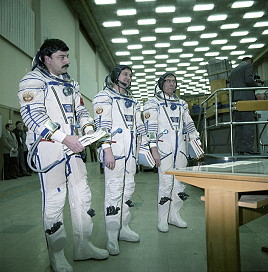 |
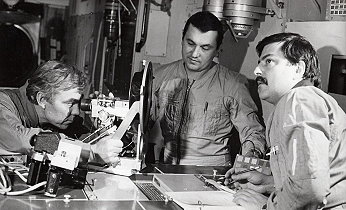 |
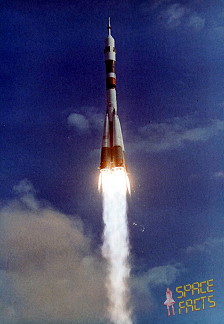 |
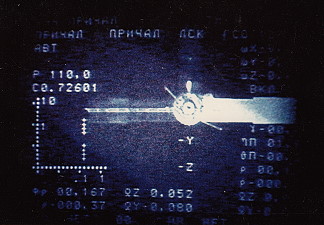 |
 |
 |
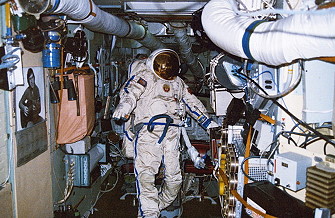 |
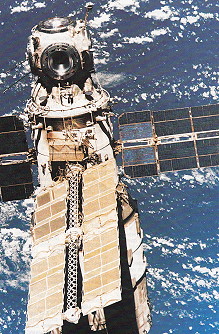 |
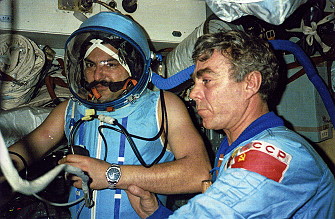 |
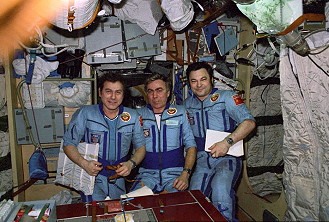 |
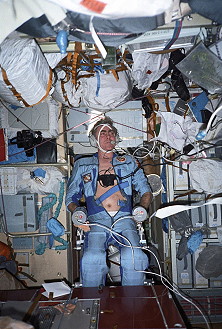 |
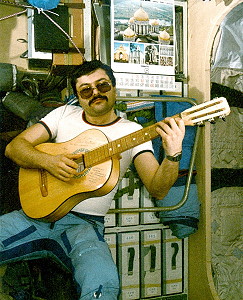 |
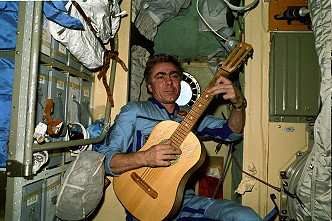 |
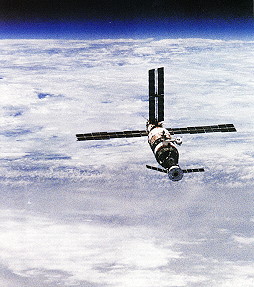 |
 |
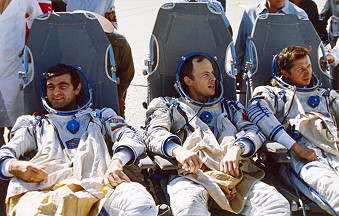 |
| © |  |
Last update on March 30, 2025.  |
 |